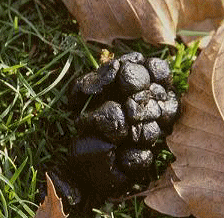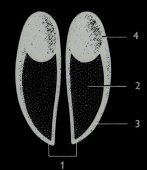
|

|
HOW TO SEE THEM
Period | Places | Odors | Tracks | Footprints
Who has never dreamt of meeting a deer in the evening haze ?
|

|
It's a rare moment but, here is some advice
on how to make the dream come true. In all the cases, it should not be forgotten that we are in their territory. One should not
behave as a conqueror but as a visitor respect ful of their peace. They are very sensitive to odors and can detect a person from
300 meters. So pay attention to the direction of the wind... Lastly, they are non-agressive except for a mother protecting her
fawn or a buck excited by the rut. In these cases they can be dangerous. Do not disturb them and observe from a distance !
Deer are rarely seen but one can see many traces of their passage : footprints, tree tracks,
odors ...
One must have patience and see the forest with other eyes.
|
Time Period |
The best period of observation is at the time of
the rut. Deer are then much less timid and show themselves more often. Moreover, their cry allows us to locate them.
The best moment of the day is during twilight. The deer is an animal with night habits whose activity increases at the sun sets.
|
 |
Places |
There are key places to observe them.
During the rut, bucks and their herd may be found in the same places known as "bellow areas". These areas are well-known
and often there are observation posts installed nearly, by forest rangers.
Muddy places are also very busy places. It is in these wet places that deer come to roll themselves in mud to get rid of parasites .
|
Odors |
|
One may not consider it but at rut time deer have a very marked musky odor. One strongly smells it at this time in the places where they have passed.
They mark their territory using an odor gland located in the inner corner of the eye which produces an odoriferous fatty
secretion. Trees and shrubs will be coated with this secretion.
|
Tracks |
 |
The most obvious signs of tracks are on tree barks. Tree truncks may be scarred after a buck feeds on the bark,
rubs his antlers against the bark or rubs his body against it leaving tufts of fur...
As deer eat tender shoots and buds of the lower branches, trees may have a "cut" aspect to them... |
Evidence of deer is visible by the tell-tale signs of excrement. They drop small oval balls which can reach 3,8 cm length. The shape of
droppings results from the structure of the final part of the large intestine: its wall consists of a series of folds.
One also observes differences in excrement according to the season and the variation in diet as it will be more or less dehydrated . |
 |
Footprints |
The observation of the prints makes it possible to define the direction, the speed, the sex, the age ...
|
 |
 |
 |
| The deer hoof consists of a spong or heel (4), a plantar plate (2),
an edge or side (3) and a point or tongs (1). Two dewclaws, vestiges of old fingers,
are near the top (5). They touch the ground only at the time of the race or the jump. |
 |
One can see a clear difference in the size of the print between a male (on the left) and a female (on the right). |
The direction is visible by the ground projection on the front of the print as well as small skids forward on slipping ground.
Deer move in four speeds: walk, trot, race and jump(the forelegs are in gray, doe legs in white).
|
 |
Walk or trot
While walking, the hind legs are posed exactly in the print of the forelegs. While trotting, there is a slight. |
 |
Race
While racing, deer launch the hind legs in front of the prints of the forelegs. Two bones
make marks unlike the walk or trot . |
 |
Jump
While leaping the doe legs are posed side by side with the forelegs shifted . |
|

|

|
|